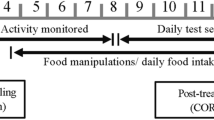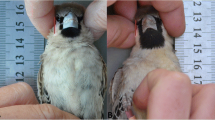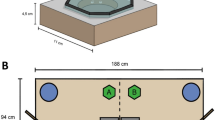Abstract
I quantified the costs of switching from a familiar to an unfamiliar flock for captive dark-eyed juncos (Junco h. hyemalis) by measuring several physiological and behavioral variables before and after flock switching. Birds that were initially dominant dropped in status in unfamiliar flocks, and experienced increased metabolic rates, while subordinate birds appeared to undergo less physiological change when switching flocks. This difference occurred despite a lack of any rank-related differences in the effects of joining a new flock on rates of aggression, weight change, access to food, or plasma corticosterone levels. These results suggest that for dominant, but not subordinate, individuals there is a measurable metabolic cost to joining a new social group, even in the absence of adverse factors such as food limitation. Dominant individuals may be less likely than subordinates to leave familiar flocks because of their higher metabolic costs when joining a new social group.
Similar content being viewed by others
References
Baker MC, Fox SF (1978) Dominance, survival and enzyme poly-morphism in dark-eyed Juncos Junco hyemalis. Evolution 32:697–711
Beletsky LD, Orians GH (1989) Familiar neighbors enhance breeding success in birds. Proc Natl Acad Sci USA 86:7933–7936
Beletsky LD, Orians GH (1991) Effects of breeding experience and familiarity on site fidelity in female red-winged blackbirds. Ecology 72:787–796
Boag DA, Alway JH (1981) Heritability of dominance status among Japanese quail: a preliminary report. Can J Zool 59:441–444
Brown J (1975) The evolution of behavior. Norton, New York
Bryant DM, Newton AV (1994) Metabolic costs of dominance in dippers, Cinclus cinclus. Anim Behav 48:447–455
Caraco T (1979) Time budgeting and group size: a test of theory. Ecology 60:618–627
Cristol DA, Nolan V Jr, Ketterson ED (1990) Effect of prior residence on dominance status of dark-eyed juncos, Junco hyemahs. Anim Behav 40:580–586
Dearborn DC, Wiley RH (1993) Prior residence has a gradual influence on dominance in captive white-throated sparrows. Anim Behav 46:39–46
Eden SF (1987) Natal philopatry of the magpie Pica pica. Anim Behav 129:477–490
Ekman J (1990) Alliances in winter flocks of willow tits; effects of rank on survival and reproductive success in male-female associations. Behav Ecol Sociobiol 26:239–245
Ekman J, Lilliendahl K (1993) Using priority to food access: fattening strategies in dominance-structured willow tit (Parus montanus) flocks. Behav Ecol 4:232–238
Fretwell S (1969) Dominance behavior and winter habitat distribution in juncos (Junco hyemahs). Bird Banding 40:1–25
Harvey S, Phillips JG, Rees A, Hall TR (1984) Stress and adrenal function. J Exp Zool 232:633–645
Hogstad O (1987) It is expensive to be dominant. Auk 104:333–336
Holberton RL, Able KP, Wingfield, JC (1989) Status signalling in dark-eyed juncos, Junco hyemalis: plumage manipulations and hormonal correlates of dominance. Anim Behav 37: 681–689
Ketterson ED, Nolan V Jr (1976) Geographic variation and its climatic correlates in the sex ratio of eastern-wintering dark-eyed juncos (Junco hyemalis hyemahs). Ecology 57:679–693
Ketterson ED, Nolan V Jr (1982) The role of migration and winter mortality in the life history of a temperate-zone migrant, the dark-eyed junco, as determined from demographic analyses of winter populations. Auk 99:243–259
Kikkawa J (1980) Winter survival in relation to dominance classes among silvereyes Zosterops lateralis chlorocephala of Heron Island, Great Barrier Reef. Auk 122:437–446
Langen TA, Rabenold KN (1994) Dominance and diet selection in juncos. Behav Ecol 5:334–338
Myers JP (1983) Space, time and the pattern of individual associations in a group-living species: sanderlings have no friends. Behav Ecol Sociobiol 12:129–134
Ortman LL, Craig JV (1968) Social dominance in chickens modified by genetic selection — physiological mechanisms. Anim Behav 16:33–37
Piper WH (1990) Site tenacity and dominance in wintering white-throated sparrows Zonotrichia albicollis (Passeriformes: Emberizidae). Ethology 85:114–122
Pyle P, Howell SNG, Yunick RP, DeSante DF (1987) Identification guide to North American passerines. Slate Creek Press, Bolinas, California
Ramenofsky M, Gray JM, Johnson RB (1992) Behavioral and physiological adjustments of birds living in winter flocks. Ornis Scand 23:371–380.
Rattner BA, Eastin WC Jr (1981) Plasma corticosterone and thyroxine concentrations during chronic ingestion of crude oil in mallard ducks (Anas platyrhynchos). Comp Biochem Physiol 68C:103–107
Rogers CM, Ramenofsky M, Ketterson ED, Nolan V Jr, Wingfield JC (1993) Plasma corticosterone, adrenal mass, winter weather, and season in nonbreeding populations of dark-eyed juncos (Junco hyemalis hyemalis). Auk 110:279–285
Roskaft E, Jarvi T, Bakken M, Bech C, Reinertsen RE (1986) The relationship between social status and resting metabolic rate in great tits (Parus major) and pied flycatchers (Ficedula hypoleuca). Anim Behav 34:838–842
Sabine WS (1949) Dominance in winter flocks of juncos and tree sparrows. Physiol Zoo 22:64–85
Sapolsky RM, Sare LJ (1994) Rank-related differences in cardiovascular function among wild baboons: role of sensitivity to glucocorticoids. Am J Primatol 32:261–275
Satterlee DG, Jacobs-Perry LA, Traux RE (1983) Circulating corticosterone response of wild-type Japanese quail to albino quail intrusion. Poult Sci 62:310–313
Smith SM (1978) The “underworld” in a territorial sparrow: adaptive strategy for floaters. Am Nat 112:571–582
Smith SM (1991) The black-capped chickadee; behavioral ecology and natural history. Comstock, Ithaca, New York
Stamps JA (1987) The effect of familiarity with a neighborhood on territory acquisition. Behav Ecol Sociobiol 21:273–277
Terrill SB (1987) Social dominance and migratory restlessness in the dark-eyed junco (Junco hyemlis). Behav Ecol Sociobiol 21:1–11
Wingfield JC, Smith PJ, Farner DS (1982) Endocrine responses of white-crowned sparrows to environmental stress. Condor 84:399–409
Wingfield JC, Vleck CM, Moore MC (1992) Seasonal changes of the adrenocortical response to stress in birds of the Sonoran desert. J Exp Zool 264:419–428
Author information
Authors and Affiliations
Additional information
Communicated by M.A. Elgar
Rights and permissions
About this article
Cite this article
Cristoll, D.A. Costs of switching social groups for dominant and subordinate dark-eyed juncos (Junco hyemalis). Behav Ecol Sociobiol 37, 93–101 (1995). https://doi.org/10.1007/BF00164154
Received:
Accepted:
Issue Date:
DOI: https://doi.org/10.1007/BF00164154




